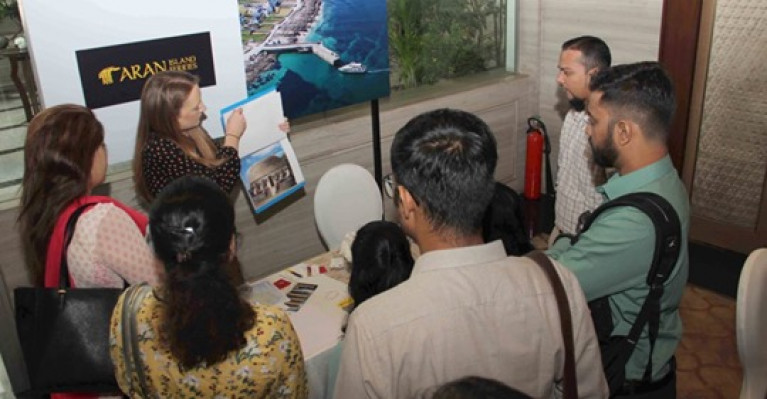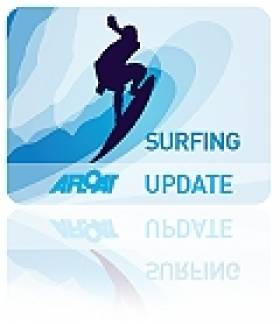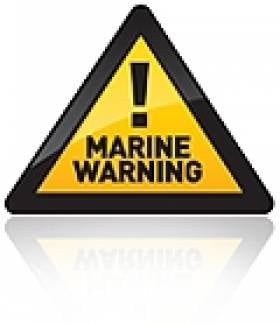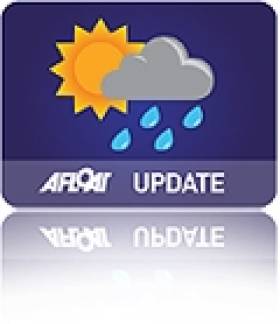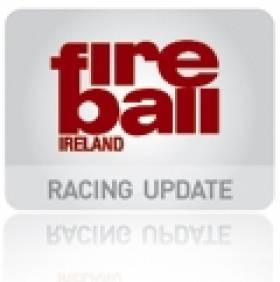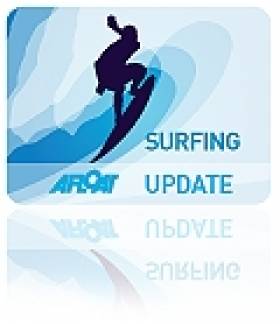Displaying items by tag: West coast
Operator to Aran Islands Travels to India as Part of Major Sales Mission
West coast operator, Aran Island Ferries travelled to India last week as part of Tourism Ireland’s sales mission in the country.
The delegation, writes GalwayDaily, of Irish tourism companies, which included hoteliers and visitor attractions, met hundreds of tour operators and travel agents in Mumbai and New Delhi.
The companies also met influential travel journalists and bloggers.
The aim of the sales mission was to build awareness of the many things to see and do on a holiday in Ireland and encourage tour operators and travel agents in India to include Ireland in their programmes and brochures for 2020 and beyond.
More here on this story.
Video: West Coast is Winter Hotspot for Surf Pros
#SURFING - Conor Conlon of CMP has produced this wonderful video of top professional surfers taking on the Atlantic swells of the west coast this winter.
Setting up his gear on the shore during a window of clean swell, Conlon captured the likes of Aaron Dees, Conor Maguire, Easkey Britton and newly signed Ripcurl rider Noah Cohen catching the waves (more photos and video HERE).
Ireland to Showcase 'Planet's Biggest Waves' on 2012 Kite Surf Tour
#KITESURFING - Ireland will be one of four stops on the 2012 Kite Surf Pro World Championship Tour to decide the best wave kitesurfers in the world, Surfer Today reports.
Kicking off in Cascais, Portugal in June before heading to Mauritius in September, the tour will come to Ireland's west coast - described as "Europe's secret kite surfing jewel and home to one of the planet's biggest waves" - from 19-28 October.
According to Surfer Today: "Ireland's Kite Surf Pro will incorporate a unique mobile format, capable of showcasing each day's action at the choicest of locations on the country's wild and swell-abundant west coast."
The tour will wrap up in Maui, Hawaii from 29 November to 8 December, where the €15,000 prize purse wil be up for grabs at the famed surfing venue of Ho'okipa.
Surfer Today has more on the story HERE.
New Helicopter for Irish Coast Guard is Completed
#COASTGUARD - Sikorsky has completed production of a new S-92 helicopter for the Irish Coast Guard under the rescue service's €500 million deal with CHC Ireland.
The US-based helicopter firm and CHC formalised the purchase on Wednesday (21 December) with Irish Coast Guard director Chris Reynolds during a hand-over ceremony at the S-92 commercial helicopter assembly facility in Coatesville, Pennsylvania.
Equipped for dedicated search and rescue (SAR) operations, the helicopter will provide coverage for deep Atlantic Ocean missions, service Ireland's offshore islands and provide rescue cover on the west coast from Cork to Galway.
The new aircraft will be based at Shannon and will replace the current coastguard SAR helicopter, a Sikorsky S-61, which has given 20 years of unbroken service.
According to Sikorsky, the S-92 is equipped with advanced systems and hardware, including an automated flight control system that enables the pilot to fly pre-programmed search patterns and perform delicate hover manoeuvres; a wireless intercom allowing a rescue swimmer to communicate with the crew; radio transceivers to communicate with ships and rescue services; a weather radar and infrared sensor; and a digital video system to record rescues.
Reynolds said the new helicopter - which joins four second-hand machines on a 10-year lease - represents a stepped improvement in Ireland's ability to care for and service its seagoing, coastal and island communities.
"I am very happy that the Coast Guard will operate what I consider to be the leading SAR helicopter in the world," he added.
As reported earlier this year on Afloat.ie, the new chopper is part of a deal that raised questions from a Fine Gael TD over allegations that a competing tender did not have a "good reputation".
Fergus O'Dowd questioning the contract with CHC Ireland after receiving documents in which Chris Reynolds said the Air Corps – whose helicopters are supplied by AgustaWestland - were uneqipped for the role and that no cost saving would be made if they took on the service.
Marine Notice: Deployment of Waverider Buoys
The latest Marine Notice from the Department of Transport, Tourism and Sport (DTTAS) advises that two Waverider buoys are set to be deployed off the west coast from tomorrow 10 October.
The buoys will be operational for between 12 and 24 months at two locations, one 6km west of Achillbeg Island, Co Mayo and one 2km north northwest of Captain's Hill, Co Clare. Both have a drift radius of up to 100m.
All vessels in the areas above are requested to give the buoys a wide berth. They will be easily spotted by their spherical shape, bright yellow colour and flash pattern (FL 5, Yellow, every 20 seconds).
Full location co-ordinates and further details are included in Marine Notice No 48 of 2011, a PDF of which is available to read and download HERE.
Hurricane Katia Set to Hit Ireland
"Phenomenal" ocean conditions will be of grave concern to vessels in Irish waters from tomorrow evening as Hurricane Katia makes its approach to Ireland.
As the Irish Independent reports, Met Éireann has considered issuing a severe weater warning today, predicting winds of up to 160kmph and sea flooding on the west coast from Donegal Bay to the Shannon estuary.
On the east coast, winds are expected to reach 130kmph in Dublin on Monday, raising the threat of falling trees and "excessive damage" to property.
The UK Met Office has already taken the rare step of issuing an extreme weather alert for the whole of Ireland.
The category one hurricane is carrying winds of up to 145kmph as it crosses the Atlantic, and is expected to make landfall on the northern half of Ireland tomorrow night.
The Irish Independent has more on the story HERE.
Galway Students Win Big for Surfing Website
Two students at NUI Galway have won a €15,000 investment in an enterprise competition for their website promoting surfing in Ireland.
Oisin Halpin and Cian Brassil of WestCoastSurfer.com took the top prize at the NUI Galway Student Enterprise Awards earlier this month, with judges convinced by their brand and ability to attract investment to the region, according to Silicon Republic.
“WestCoastSurfer.com has huge growth potential and is well grounded in commercial reality with great opportunities for the West of Ireland,” said chairperson of the judging panel Helen Ryan.
Fireball Worlds Sligo, Two weeks and Counting!
This morning, Friday 27th May, the entry stands at 58 boats, spread across 9 nations and 3 continents. The spread of countries covers Ireland, United Kingdom, Switzerland, Australia, Shetland Islands, France, Czech Republic, Canada and Germany, with the continents being Europe, Australia and North America.
The home contingent boasts 28 boats, followed by GBR with 17 boats, France and Switzerland have three entries each, Canada and the Czech Republic 2, with Australia, the Shetlands and Germany each having one. However, there is a late attempt to get a second Australian entry to the event and in fact with entries being open right up to the eve of the regatta, there is always the prospect that more boats may still declare. I also know of one entry that isn't on the list yet as the crew was only secured last weekend and the boat is still being finished out.
So which names stand out in the entry list thus far?
Tom Gillard and Sam Brearey are the current European Champions having won that title in the Czech Republic in Pavlov last October. They gave a very convincing display in that regatta and have shown good form in the UK regattas they have sailed to date. Tom has also "dabbled" recently in the Scorpion scene in UK with success. Also on the podium in Pavlov was Jaroslav Verner of the Czech Republic who has entered for Sligo with a different crew. From further afield and the sole Aussie thus far, is Ben Schulz, sailing with Phillip Bowley, who finished 5th in the 2010 Worlds in Barbados. Ben is the current Secretary of Fireball Australia.
As the largest Fireball fleet internationally, the UK fleet always brings quality to these events and the entry list for Sligo reflects that continuing trend. Defending champions Chips Howarth and Vyv Townend are not entered, but the British contingent is like a "Who's who" of the class there.
Vince Horey, 11th in Barbados races with Andy Thompson, Matt Burge & Richard Wagstaff, 2nd in Barbados sail together again in Sligo, Simon Potts, 3rd placed crew in Barbados teams up with David Wade, 6th placed helm in Barbados and 6th placed crew in Barbados, Tim Saunders, current UKFA Chairman, teams up with Alan Krailing. For those who follow the Fireball scene in the UK and internationally, these are almost household names!
Messrs Jospe & Egli are perennial competitors at international regattas and they are joined by Messrs Tipton & King. Both combinations contested the Barbados event.
European Commodore Maja Suter is part of a 3-boat Swiss representation which also includes another Fireball stalwart in Ruedi Moser. The French contingent has a similar profile with 3 boats and Jean-Pierre Nouel (Monsieur Cantona) their most travelled competitor.
Of the Irish contingent, the names that will be vying for first home boat will include, on current form, Graeme Grant & Hugh Butler, Noel Butler & Stephen Oram, Barry McCartin & Conor Kinsella and Kenny Rumball & Seamus Moore. Much will depend on the weather, but a 28 boat contingent is great news for the host fleet and bodes well for an interesting session of racing.
Sligo here we come!
Mariners Advised on West Coast Seismic Survey
The Department of Transport's latest marine notice advises seafarers off the west coast to keep a lookout while a 3D seismic survey is conducted over the next three weeks.
The vessel M/V Ramform Vanguard that will carry out the work will be towing 10 streamers 6km long and will have a minimum turning radius of 3km.
Due to this restriction in manoeuvrability, all boats in the area are requested to give the vessel a wide berth.
The vessel's planned locations are listed in the PDF of Marine Notice No 24 of 2011, which is available to read or download HERE.
Prowlers Could Boost Tourism in West
The 50ft monster waves that arose off Ireland's west coast last week could provide a significant boost to tourism in the region.
Ethna Murphy of Fáilte Ireland told The Irish Times that images and news reports of the Prowlers waves has given them "priceless publicity" ahead of next autumn's European Surfing Championships in Bundoran.
"Those photographs will be in every surfing magazine in the world that matters and that is how we attract visitors to Ireland," added Killian O'Kelly of Bundoran's TurfnSurf Lodge surf school.
Last week's Fáilte Ireland conference on adventure tourism in Killarney was told that the market is worth over €1 billion annually, attracting over a million visitors to Ireland each year.
Prowlers has enhanced Ireland's already growing reputation as one of the top cold-water surfing spots in the world.
But the location of the giant waves as yet remains a secret known only to a handful of intrepid surfers.


























